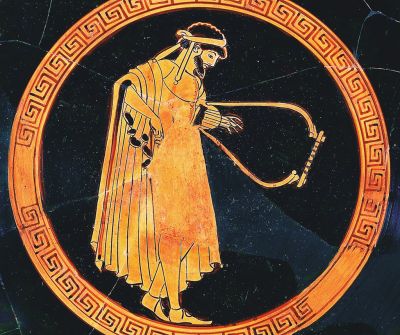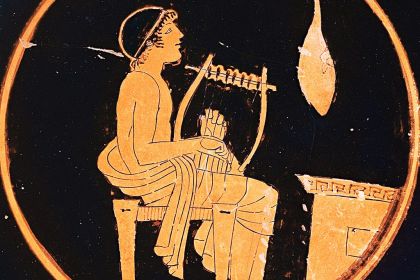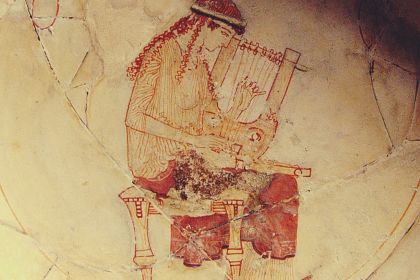Music Theory
5 songs featuring Dorian mode

Terracotta Kylix by Dokimasia Painter
Musical Mode: Dorian Mode
Out of all seven diatonic scales, the major and minor scales have been the two most prevalent in Western music throughout centuries. The vast majority of compositions, whether in classical or popular music, are written in the minor or major mode, giving other diatonic scales secondary roles.
In musical theory, the minor and major modes have a harmonic structure that allows the combination of all three harmonic functions—tonic, subdominant, and dominant—in the most advanced way. The remaining five modes, Dorian, Phrygian, Lydian, Mixolydian, and Locrian, are structured in such a way that only two of the three harmonic functions can be fully applied.
The Dorian mode differs from the natural minor in only one change of the sixth scale degree which is raised by a semitone and therefore becomes separated from the fifth scale degree by a whole tone.
C Dorian scale:

Among the triads built on each scale degree of the Dorian mode, there are three major chords rooted in the third, fourth, and seven degrees, as well as three minor chords rooted in the first, second, and fifth degrees. For example, C Dorian mode contains the following triads (denoted by Roman numerals and chord symbols): i–Cm, ii–Dm, III–E♭, IV–F, v–Gm, vio–Adim, VII–B♭.

Among the triads built on each scale degree of the Dorian mode, there are three major chords rooted in the third, fourth, and seven degrees, as well as three minor chords rooted in the first, second, and fifth degrees. For example, C Dorian mode contains the following triads (denoted by Roman numerals and chord symbols): i–Cm, ii–Dm, III–E♭, IV–F, v–Gm, vio–Adim, VII–B♭.
The Roman numeral analysis of C Dorian mode:

The Dorian mode is considered to be a minor one since the tonic chord on which it is built in the first scale degree is minor. Compared to the natural minor, a raised sixth scale degree introduces changes in all chords of the subdominant family: the fourth scale degree triad is a major chord, the second scale degree triad, also known as the supertonic, is a minor chord, and finally, the sixth scale degree triad is a diminished chord.

The Dorian mode is considered to be a minor one since the tonic chord on which it is built in the first scale degree is minor. Compared to the natural minor, a raised sixth scale degree introduces changes in all chords of the subdominant family: the fourth scale degree triad is a major chord, the second scale degree triad, also known as the supertonic, is a minor chord, and finally, the sixth scale degree triad is a diminished chord.
One of the most famous examples of the Dorian mode is found in the iconic Another Brick In The Wall released by Pink Floyd in 1979. Here, D Dorian appears in verses based on a two-chord chain Dm–G–Dm or i–IV–i, while choruses containing the chord progression F–C–Dm or III–VII–i can simultaneously be referred to the Dorian mode as well as to the natural minor since the chords featured in the chorus do not contain the sixth scale degree which distinguishes the two modes.
Listen to Another Brick In The Wall by Pink Floyd:
E Dorian is seen in the famous sea shanty Drunken Sailor which contains the following chord chains as arranged by the Canadian folk band The Irish Rovers:
- Em–D–Em–G–D–Em or i–VII–i–III–VII–i for verses and choruses
- Em–D–Em–A–D or i–VII–i–IV–VII for instrumental sections
In this example, only the instrumental sections reveal the Dorian mode since the chords used in the verses and choruses do not contain the sixth scale degree and hence can be interpreted both as the Dorian mode and as the natural minor.
Listen to Drunken Sailor by The Irish Rovers:
Traced back to the 17th century, the traditional English ballad Scarborough Fair owes its current popularity to the American folk-rock duo Simon & Garfunkel whose version of the song is arranged using A Dorian. Here are the chord progressions for each line of the song's verses:
- Am–G–Am or i–VII–i
- C–Am–C–D–Am or III–i–III–IV–i
- Am–C–G–Am–G or i–III–VII–i–VII
- Am–G–Am or i–VII–i
The Dorian mode appears here in the second line containing D major chord which is the subdominant chord built in the fourth scale degree.
Listen to Scarborough Fair by Simon & Garfunkel:
All sections of Tears for Fears' Mad World are written in A Dorian as seen in the following chord chains:
- Am–C–G–D or i–III–VII–IV for verses and instrumental
- Am–D or i–IV for choruses
- Am–C–D or i–III–IV for refrain
Listen to Mad World by Tears for Fears:
A very interesting harmonic sequence in B Dorian was composed by Deep Forest for their piece Sweet Lullaby in which the music is set to accompany an archival entomological recording of a traditional lullaby of the Solomon Islands. Here, the original vocals are accompanied by the following sequences:
- Bm–D–Bm–F♯m–D–Bm–E–F♯m–D or
i–III–i–v–III–i–IV-v - Bm–F♯m–D–A–D–Bm–E–F♯m–D or i–v–III–VII–III–i–IV-v
Listen to Sweet Lullaby by Deep Forest:
All given examples show only one subdominant family chord built on the fourth scale degree, although the use of a supertonic minor chord built in the second degree of the Dorian mode is also harmoniously appropriate.
Discover more songs composed in Dorian minor mode and check out their harmonic analysis in the following articles:
- Dorian mode in Led Zeppelin songs
- Beatles songs with Dorian mode
- No Quarter: two minor modal modes of Led Zeppelin's psychedelic track
- Knights of Cydonia: Dorian-mode refrain boosting best Muse song
- El Farsante and 7 more songs by Ozuna in Dorian and Aeolian modes



